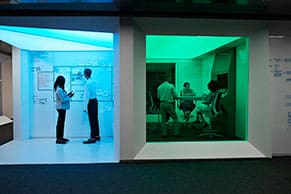Enterprise resource planning (ERP) is a mainstay technology in businesses that want to gather, analyze and share insights among multiple departments, such as accounting, operations, manufacturing and sales, from a single database. While ERP systems are great at connecting the dots between business processes to find efficiencies, these days, remaining competitive calls for even more: Real-time data analysis and insights that help organizations make smarter decisions.
Enter business intelligence technology, or BI. Combined, ERP and BI increase a company’s agility, help leaders with oversight and pave the way to business success.
What Is ERP?
Organizations use ERP software to automate business processes and gain a central hub for insights and controls. A modern ERP system draws on a central database that collects inputs from departments including finance, manufacturing, operations, sales and marketing and human resources (HR). Thanks to that central database, stakeholders gain cross-departmental insights that they can use to analyze various scenarios, perform financial planning and analysis (FP&A) and teasing out process improvements that can translate to major efficiency gains, cost savings and better productivity as people spend less time searching for needed data.
That sums up an ERP systems’ key value: the ability to optimize and automate essential operational processes, such as financial, supply chain and production management, freeing up time and resources for strategic endeavors.
What Is Business Intelligence (BI)?
Like ERP systems, business intelligence (BI) software provides companies with a comprehensive view of their operations, enabling leaders to base business decisions on data. BI also plays a central role in both high-level strategy and tactical responses to market demands, helping businesses operate more efficiently, focus on their competitive advantages and ultimately increase profitability.
In practice, BI helps generate dashboards, reports, customer-facing IT systems and external sources to deliver a detailed, transparent view of the business’s current standing by pulling data from a centralized repository. It produces comprehensive, detailed analyses that help users improve operations in both their front and back offices. For instance, if a retailer is experiencing supply chain issues, analysis from BI can pinpoint operational bottlenecks and devise a plan to reroute shipments through a more reliable route.
What Are the Key Differences Between ERP and BI?
ERP and BI overlap in many ways, but they have different strengths. An ERP system primarily serves as a process management software that manages and integrates important business processes like manufacturing, inventory management, financials, supply chain, etc. As a unified process system, centralized data breaks down silos and promotes greater efficiency across the organization. BI takes this data further, enabling businesses to organize, analyze and contextualize information from around the company to generate actionable insights.
The creation of dashboards and other visualizations to make complex data easier to understand.
ERP and BI also support different levels of decision-making. ERP systems add most value at the operational level, giving businesses a precise view of how each of their functions is performing at the moment. BI analyzes that and other data, helping companies dive deeper into their performance metrics and uncover trends that, in turn, can be used to fine-tune their strategies at a high level, a granular level — or both.
Whether for analyzing the ROI of a new digital marketing strategy or calculating the cost savings delivered by a more real-time approach to inventory management, BI systems drive performance improvements while containing costs, including saving time and resources.
OLTP + OLAP: Better Together
An online transaction processing (OLTP) system is a data processing system used by enterprises to record transactions. ERP is an example of an OLTP system. Business intelligence, on the other hand, is built on an online analytical process (OLAP) system, which offers multidimensional analytical capabilities.
| OLTP | OLAP |
|---|---|
| Constantly updated | Less frequent updates |
| Operational data sources | Consolidated data sets |
| Relatively standardized queries | Complex, freeform queries |
| Returns responses quickly | May take some time to process queries |
| Original data source of record Captures and maintains transaction data in a database, such as purchase transaction or vendor payment |
Draws data from multiple sources, including ERP |
Evolution of ERP and BI
ERP has its roots in the material requirements planning systems used by manufacturers in the 1960s. In the 1980s, these systems evolved to manufacturing resource planning systems, helping to improve production planning. The unified business management platform debuted the following decade, paving the way for on-premises, then hosted, then cloud-based ERP to consolidate business-wide processes onto one central database and make insights available anytime, anywhere.
BI had a similar trajectory, with roots in the decision-support systems introduced in the 1960s and further developed through the 1980s. BI started to take off as an on-premises solution in the late 1990s; only in the past few years have vendors started to offer BI solutions in the cloud.
Nowadays, ERP systems are typically integrated with BI in the cloud. Not only does this remove the burden of hosting, maintaining and paying for on-premises infrastructure, it allows for real-time integration of data between systems and, as a result, smarter decision-making.
Integration of Business Intelligence and ERP
Data and analysis have always been at the core of sound business decision-making. But these days the vast amounts of data, structured and unstructured, that companies collect mean they require a way to organize, store and analyze this information at scale. The integration of ERP and BI brings everything together, helping users consolidate millions of data points into clear, actionable insights.
Forward-looking businesses want to shift from historical reporting to predictive modeling, that has also driven the rising popularity of ERP-BI integration. The ability to spot trends and patterns, anticipate shifts in the market and proactively adjust plans are all competitive advantages in today’s digital economy.
Why Business Intelligence in ERP?
BI and ERP software are not only complementary, they enhance each other’s performance.
ERP systems are integral to data analysis, breaking down silos between essential functions like finance, HR, operations and sales. BI turns all of these information sources into more than the sum of their parts, drawing on operational data from the ERP system and advancing it into actionable insights that directly serve the business’s strategic ambitions.
Consider the example of a grocery retailer that needs to constantly refine its inventory and delivery logistics to keep costs in check and avoid spoilage of perishable products. With a real-time view of its inventory, supply chain and customer demand, the retailer can strike the right balance between volume, speed and waste.
Today, BI cannot exist without ERP. BI software mines ERP databases and, via dashboards and other visualizations, makes it easier for stakeholders across the business to consume insights. Meanwhile, ERP systems play a bigger role in strategic decision-making when elevated by BI capabilities.
7 Benefits of Business Intelligence in ERP
BI enhances ERP systems in a number of ways besides turning data into visual analyses that inform decision-making across the organization. Here’s a closer look at seven key benefits of ERP-BI integration:
-
Data aggregation and analysis: ERP systems generate enormous volumes of raw data, and there is always more value to be unlocked from this information. With BI integrated in their ERPs, businesses can draw in-depth insights from their data directly within their ERP platforms.
-
Customization: Even when every team in a business is working toward a common goal, individual stakeholders may have their own data analysis mandates and requirements. An integrated BI-ERP system allows each team to generate the reports and dashboards they need to meet their objectives.
-
Predictive capabilities: Historical ERP data offers insights into past performance, while BI opens the door to predictive analysis and modeling. Together, they offer companies an end-to-end view of their past, present and possible future.
-
Real-time decisions: Traditional reporting is retrospective, but, as noted above, businesses need to get more predictive to stay competitive. That is where BI comes in, delivering data and analyses in real time to fuel better, faster decision-making.
-
Comprehensive insights: When BI and ERP are integrated, businesses don’t have to go back and forth between technologies to assess their performance. All the necessary data is in one place, ready to be used for simple reporting, predictive modeling or to answer specific queries.
-
Efficiency: BI integrated within ERP allows companies to consolidate, organize and analyze large data sets from multiple sources in real time. This added speed removes a significant barrier that has traditionally hampered business agility.
-
Reporting: BI enhances reporting by allowing teams to incorporate larger datasets for deeper analyses, all while speeding up the report-generation process. Moreover, simple dashboards make reports accessible to authorized users across the organization, no matter their level of technical expertise.
Examples of ERP With Business Intelligence
Companies of all sizes and across every industry stand to benefit from an integrated approach to ERP and BI. Retailers, for example, can adjust their inventory and marketing strategies as they transition to ecommerce. B2B technology companies stand to gain a better picture of how marketing drives revenue at every stage of the funnel and then optimize their ad spend. The list goes on.
Benefits cross roles as well. For example, CFOs are now involved in activities to improve sales, the customer experience and even product sets. They can draw on real-time BI dashboards for all these while helping line-of-business leaders play a more strategic role in boardroom decisions about investment areas.
Operations managers can unlock new links between manufacturing processes and product quality, adjusting their approaches to ensure the highest quality at the lowest cost. Customer experience leaders can analyze data from physical and digital sales channels to ensure they are delivering a consistent experience.
In short, BI integrated with ERP allows decision-makers to drill down into data and understand how the pieces of their operations mesh. With that knowledge, they can ask the right questions, find the root causes behind changes in sales or performance and address issues proactively rather than waiting for the market to dictate their next moves.
Future of Business Intelligence in ERP
As ERP and BI continue to evolve, the two technologies will become even more intertwined. Data and analytics will play an even bigger role in shaping business strategy, and decision-makers will increasingly seek — and rely on — real-time insights into their operations.
Together, ERP and BI will also promote greater collaboration among teams. ERP systems eliminate data silos between functions, while BI allows decision-makers to combine knowledge and join forces as they work toward common goals.
The most useful ERP systems help companies stay on top of their data and operations. But it takes the analytical capabilities of BI to consolidate and interpret large data sets to make them understandable and actionable. An integrated ERP-BI solution brings those valuable functions together, in one place, in real time and at the disposal of the entire organization. Additional benefits include trendspotting, which gives businesses time to proactively adjust their strategies, and enhanced reporting based on larger data sets.
Taken together, ERP and BI help organizations make more informed decisions more quickly, improve business oversight and win in a competitive landscape.
ERP and Business Intelligence FAQs
Q: What are the stages of business intelligence?
A: Business intelligence can be broken down into four stages. The first stage is to gather data. Next, the data is consolidated and cleansed, readying it for analysis. The next is the creation of the analysis, dashboard, KPIs or reports. Once complete, reports and dashboards are shared with relevant stakeholders across the business.
Q: What is an example of business intelligence?
A: Business intelligence is valuable for many reasons. For instance, it can be particularly helpful for forecasting. A retailer may leverage BI to help it more accurately predict demand over a given period based on a mix of historical data and real-time market conditions.
Q: How is OLTP different from ERP?
A: An online transaction processing (OLTP) system is a data processing system used by enterprises to record transactions. ERP is an example of an OLTP system. Business intelligence, on the other hand, is built on an online analytical process (OLAP) system, which offers multidimensional analytical capabilities.
Q: What is ERP in production?
A: ERP solutions make production and manufacturing processes more efficient by giving companies greater insights into their HR, supply chain, production and quality assurance systems. They also promote greater transparency and communication between teams involved in the production workflow.









